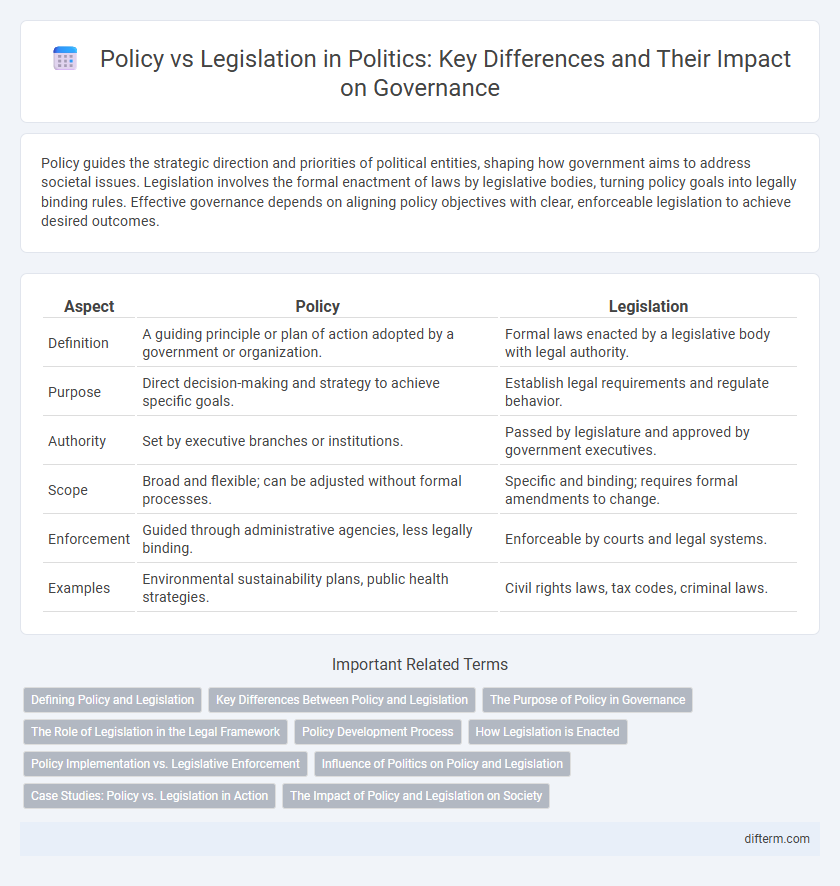Policy guides the strategic direction and priorities of political entities, shaping how government aims to address societal issues. Legislation involves the formal enactment of laws by legislative bodies, turning policy goals into legally binding rules. Effective governance depends on aligning policy objectives with clear, enforceable legislation to achieve desired outcomes.
Table of Comparison
| Aspect | Policy | Legislation |
|---|---|---|
| Definition | A guiding principle or plan of action adopted by a government or organization. | Formal laws enacted by a legislative body with legal authority. |
| Purpose | Direct decision-making and strategy to achieve specific goals. | Establish legal requirements and regulate behavior. |
| Authority | Set by executive branches or institutions. | Passed by legislature and approved by government executives. |
| Scope | Broad and flexible; can be adjusted without formal processes. | Specific and binding; requires formal amendments to change. |
| Enforcement | Guided through administrative agencies, less legally binding. | Enforceable by courts and legal systems. |
| Examples | Environmental sustainability plans, public health strategies. | Civil rights laws, tax codes, criminal laws. |
Defining Policy and Legislation
Policy represents a strategic framework guiding decision-making and objectives within a political system, while legislation consists of formal laws enacted by a governing body to implement or enforce those policies. Policies are often broad guidelines developed by government agencies or organizations, whereas legislation provides the legal authority and structure necessary to operationalize these policies. Understanding the distinction between policy and legislation is crucial for analyzing governmental processes and their impact on public administration.
Key Differences Between Policy and Legislation
Policy represents a strategic framework developed by governments or organizations to guide decision-making and achieve specific goals, often reflecting broader social, economic, or political objectives. Legislation consists of formal laws enacted by legislative bodies, providing legal authority and enforcement mechanisms to regulate behavior and ensure compliance. While policy shapes intent and direction, legislation concretizes these intentions into binding rules with defined consequences for violations.
The Purpose of Policy in Governance
Policy serves as a strategic framework guiding government decisions and actions aimed at addressing public issues and achieving societal goals. It establishes priorities, allocates resources, and sets the direction for legislative measures to be developed and implemented. Effective policy ensures coherence and consistency in governance, shaping the foundation upon which laws are enacted.
The Role of Legislation in the Legal Framework
Legislation serves as the definitive legal framework that translates policy objectives into enforceable laws, providing clear guidelines and standards for governance and public conduct. It establishes the legal authority necessary to implement policies effectively, ensuring accountability and consistency within the political system. By codifying policy decisions, legislation facilitates judicial interpretation and enforcement, reinforcing the rule of law in democratic societies.
Policy Development Process
The policy development process involves identifying public issues, setting agendas, and formulating effective strategies to address societal challenges. Legislation formalizes these policies through legal enactments by legislative bodies, ensuring enforceability and compliance. Effective policy development requires stakeholder engagement, evidence-based analysis, and iterative evaluation to create sustainable and impactful solutions.
How Legislation is Enacted
Legislation is enacted through a structured process involving drafting, committee review, and multiple readings in legislative chambers before receiving executive approval. Elected lawmakers propose bills reflecting public policy goals, which undergo debate and amendments to ensure legal clarity and alignment with societal needs. The formal enactment solidifies policy intentions into binding law, enabling enforcement and governance.
Policy Implementation vs. Legislative Enforcement
Policy implementation involves executing strategic decisions and programs set by governmental or organizational authorities to achieve specific social or economic goals. Legislative enforcement focuses on the legal mechanisms and regulatory frameworks that ensure compliance with laws passed by legislative bodies. Effective governance requires balancing proactive policy implementation with robust legislative enforcement to translate political objectives into tangible outcomes.
Influence of Politics on Policy and Legislation
Political dynamics shape policy formulation by prioritizing certain issues based on party ideologies and voter interests, directly affecting legislative agendas. Lawmakers translate these political priorities into legislation, reflecting the balance of power within government institutions. The influence of political actors, such as interest groups and lobbyists, further steers both policy decisions and the drafting of laws.
Case Studies: Policy vs. Legislation in Action
Case studies in politics reveal stark differences between policy and legislation, highlighting how policies often serve as guiding frameworks while legislation enforces binding rules. For instance, climate change initiatives demonstrate policy-driven strategies promoting renewable energy, whereas legislation mandates emission standards with legal penalties. The effectiveness of these approaches depends on the clarity of objectives, stakeholder engagement, and enforcement mechanisms within diverse political environments.
The Impact of Policy and Legislation on Society
Policy establishes the strategic framework guiding governmental priorities and public programs, while legislation provides the legal authority and enforceable rules that implement these policies. The interplay between policy and legislation shapes social behavior, economic development, and public welfare, influencing areas such as healthcare, education, and civil rights. Effective alignment of policy objectives with legislative measures ensures accountability, promotes social equity, and drives sustainable societal progress.
policy vs legislation Infographic

 difterm.com
difterm.com